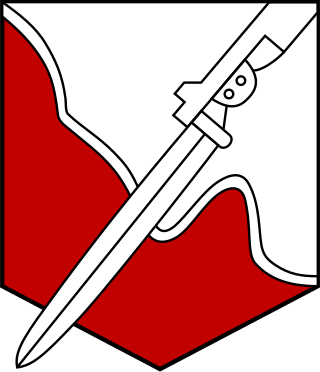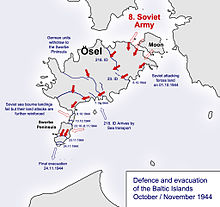
The 8th Panzer Division was a formation of the WehrmachtHeer. The division was formed by reorganising the 3rd Light Division in October 1939. It was transferred to the west and fought in the Battle of France, in May 1940, and the German invasion of the Balkans in April 1941. Soon after the division advanced towards Leningrad under Army Group North in Operation Barbarossa, and would remain on the eastern front for the remainder of the war. Staying on defensive fronts, it saw action in the relief of Kholm in 1942, Orel and the withdrawals of Army Group Centre in 1943, until transferred to Army group South. The division then fought in a series of retrograde movements, back through Ukraine, into Hungary and finally into Silesia and surrender in May 1945.

The 6th Panzer Division was an armoured division in the German Army, the Heer, during World War II, established in October 1939.

The 12th Panzer Division was an armoured division in the German Army, established in 1940.

The Courland Pocket was an area of the Courland Peninsula where Army Group North of Nazi Germany and the Reichskommissariat Ostland were cut off and surrounded by the Red Army for almost a year, lasting from July 1944 until 10 May 1945.

The 28th Jäger Division was a German military unit during World War II.

The 32nd Infantry Division of the German Army was mobilized on 1 August 1939 for the upcoming invasion of Poland. At that time, it consisted of the usual German Infantry Division elements: three infantry regiments of three battalions each, one three-battalion regiment of light artillery, one battalion of heavy artillery, a Panzerjäger (anti-tank) Battalion, a reconnaissance (Aufklärungs) Battalion, a Signals Battalion, a Pioneer (Engineer) Battalion, and divisional supply, medical, and administrative units.

The 83rd Infantry Division,, was a German reserve and security formation during World War II.

The 14th Panzer Division was an armoured division in the German Army during World War II. It was created in 1940 by the conversion of the 4th Infantry Division.

The 25th Infantry Division was a military unit of the German Wehrmacht. It was later reclassified to 25th Motorized Infantry Division, and in June 1943 to the 25th Panzergrenadier Division.

The German 8th Infantry Division was formed in Oppeln on 1 October 1934 under the cover name Artillerieführer III which was used until 15 October 1935. It was mobilized in August 1939 and took part in the Invasion of Poland, the Battle of France and Operation Barbarossa, the invasion of the Soviet Union. On 1 December 1941, it was reorganized and redesignated 8th Light Infantry Division. It was again redesignated on 30 June 1942 as the 8th Jäger Division. It surrendered to the Red Army in Moravia in May 1945.

The 45th Infantry Division was an infantry division of the army of Nazi Germany during World War II. Towards the end of the war, the division was reassembled into a second iteration, the 45th Volksgrenadier Division

The 93rd Infantry Division was a German infantry division that was formed in the fall of 1939. The division fought in the Second World War in both the Battle of France and on the Eastern Front. It was ultimately destroyed by the Red Army in March 1945 while defending East Prussia.

The 31st Infantry Division was a German infantry division of the Army during World War II. It participated in the invasion of Poland in 1939 then the invasion of France and the Low Countries in 1940. As part of Panzergruppe 2. of Army Group Centre, it was involved in the invasion of the Soviet Union in June 1941. After hard fighting throughout 1941 and 1942 it joined the 9th Army and fought in the Battle of Kursk in July and August 1943. Along with the rest of the 9th Army, the division conducted a fighting withdrawal for the remainder of 1943, during which it sustained heavy casualties. In the early stages of the Soviet Operation Bagration of June to August 1944, the 31st Infantry Division was destroyed, a fate which subsequently befell most of Army Group Centre. The division was officially disbanded on 18 July 1944.

The 34th Infantry Division,, was a German military unit that fought in the Battle of France and on the Eastern Front during World War II. The division was first formed following the expansion of the army under Adolf Hitler's leadership, but finally disbanded following their surrender to the Americans in Italy.

The 197th Infantry Division was a Wehrmacht division in World War II. It was activated on 1 December 1939.

The 81st Infantry Division was an infantry division of the German Army during World War II. It was active from 1939 until 1945 and served primarily on the Eastern Front.

The 205th Infantry Division was a German infantry division of the Heer during the Second World War. It was initially known as the 14th Landwehr Division.

The 258th Infantry Division was an Infantry Division of the German Army in World War II.
The 290th Infantry Division was a German infantry division in World War II. It was formed in the Munster Training Area in Wehrkreis X on 6 February 1940 and surrendered to Soviet forces at the end of the war as part of Army Group Courland.

The 215th Infantry Division (215.Infanterie-Division) was a major military unit of the German Army that served in World War II.






















